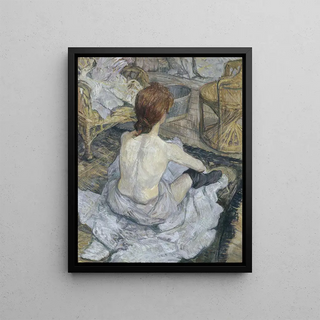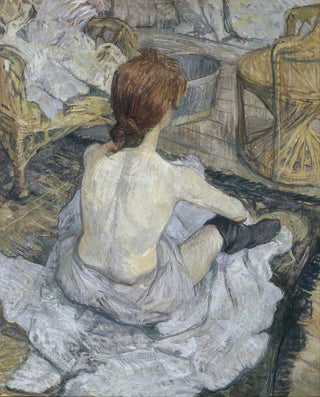Art print | Rousse also known as La Toilette - Henri de Toulouse-Lautrec


View from behind

Frame (optional)
In the vibrant world of art, some works stand out for their ability to capture the essence of a particular era. "Rousse also called The Toilet" by Henri de Toulouse-Lautrec is one of these iconic creations. Painted at the end of the 19th century, this canvas witnesses a pivotal moment where art blends with everyday life, revealing both the beauty and melancholy of the human condition. By immersing oneself in this piece, the viewer is invited to explore the subtleties of a world in full transformation, where the glamour of Parisian cabarets coexists with the intimacy of bourgeois salons.
Style and uniqueness of the work
L Toulouse-Lautrec's work is characterized by a bold approach to color and composition. In "Rousse also called The Toilet," the artist uses warm tones and simplified forms to evoke the sensuality and fragility of his model. The woman's posture, captured in a moment of vulnerability, is both intimate and universal. Fluid lines and delicate contours give a lightness to the whole, while the subtly suggested background allows the viewer to focus on the main subject. This piece does not merely depict a scene; it tells a story, that of a woman preparing to face the outside world, while revealing the tensions between appearance and reality.
The artist and his influence
Henri de Toulouse-Lautrec, an emblematic figure of the post-impressionist movement, managed to leave his mark on his era with a unique style and daring artistic vision. Coming from an aristocratic family, he quickly distanced himself from conventions to embrace the nocturnal life of Montmartre, where he found inspiration among artists, dancers, and prostitutes. His sharp eye on society of his time allowed him to capture fleeting moments with rare intensity. Lautrec's influence is still felt today, both in the field of painting and in advertising and illustration. His innovative approach, which blends realism and stylization, paved the way for many artists.

Matte finish

View from behind

Frame (optional)
In the vibrant world of art, some works stand out for their ability to capture the essence of a particular era. "Rousse also called The Toilet" by Henri de Toulouse-Lautrec is one of these iconic creations. Painted at the end of the 19th century, this canvas witnesses a pivotal moment where art blends with everyday life, revealing both the beauty and melancholy of the human condition. By immersing oneself in this piece, the viewer is invited to explore the subtleties of a world in full transformation, where the glamour of Parisian cabarets coexists with the intimacy of bourgeois salons.
Style and uniqueness of the work
L Toulouse-Lautrec's work is characterized by a bold approach to color and composition. In "Rousse also called The Toilet," the artist uses warm tones and simplified forms to evoke the sensuality and fragility of his model. The woman's posture, captured in a moment of vulnerability, is both intimate and universal. Fluid lines and delicate contours give a lightness to the whole, while the subtly suggested background allows the viewer to focus on the main subject. This piece does not merely depict a scene; it tells a story, that of a woman preparing to face the outside world, while revealing the tensions between appearance and reality.
The artist and his influence
Henri de Toulouse-Lautrec, an emblematic figure of the post-impressionist movement, managed to leave his mark on his era with a unique style and daring artistic vision. Coming from an aristocratic family, he quickly distanced himself from conventions to embrace the nocturnal life of Montmartre, where he found inspiration among artists, dancers, and prostitutes. His sharp eye on society of his time allowed him to capture fleeting moments with rare intensity. Lautrec's influence is still felt today, both in the field of painting and in advertising and illustration. His innovative approach, which blends realism and stylization, paved the way for many artists.






